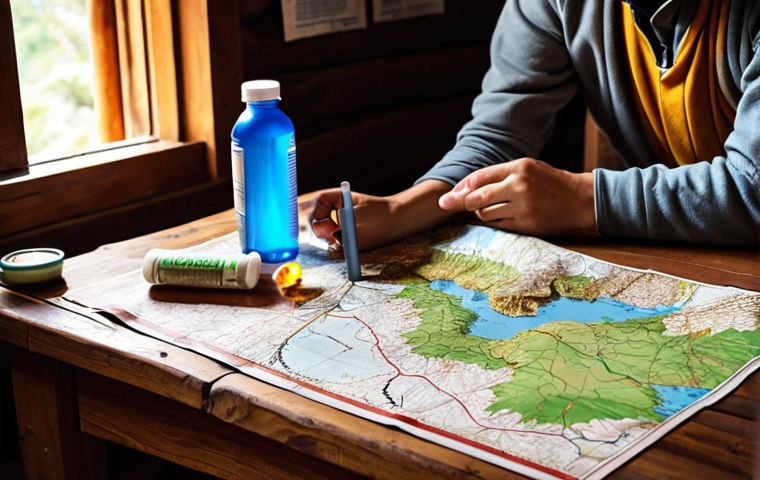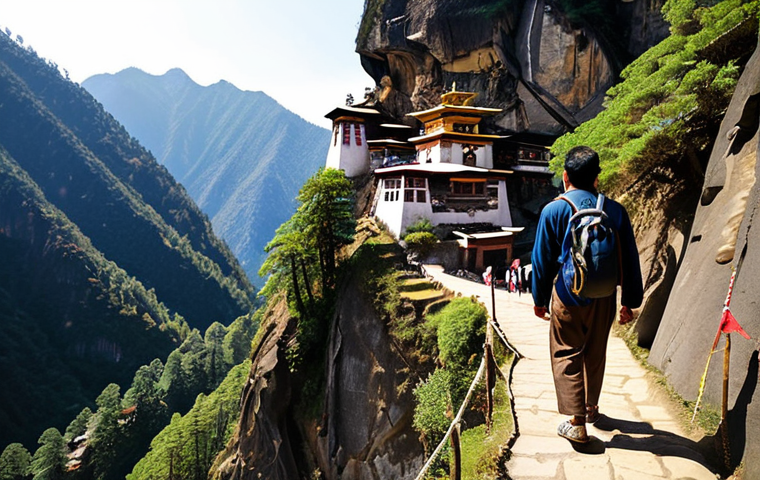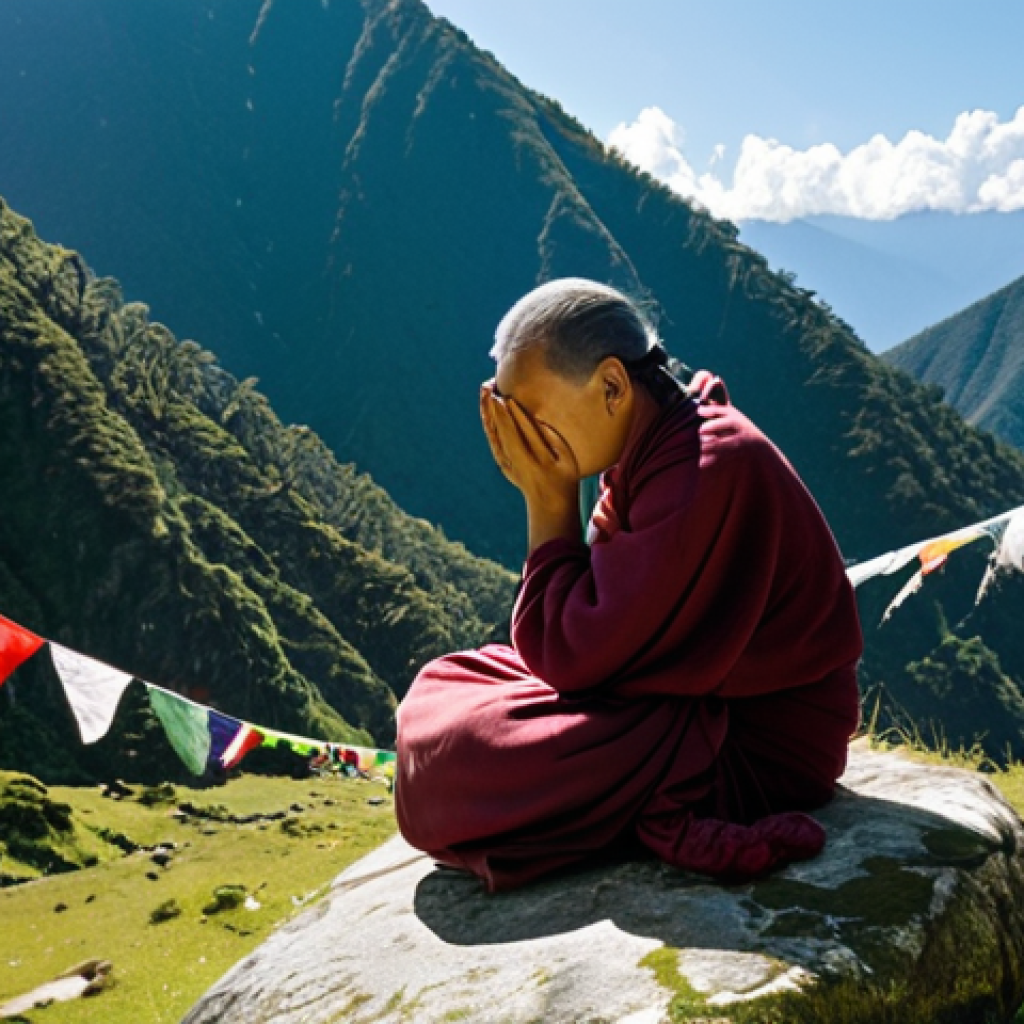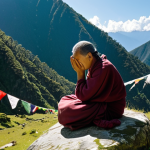Bhutan. The very name conjures images of majestic mountains, serene monasteries, and a spiritual journey unlike any other. I remember the sheer excitement bubbling inside me as I planned my first trip to this ‘Land of the Thunder Dragon.’ But amidst all that anticipation, a quiet concern lingered – the altitude.
It’s a common worry, and for good reason. As breathtaking as Bhutan’s landscapes are, many of its most iconic trails and sights sit comfortably above 2,500 meters, some even soaring past 5,000.
I’ve learned, sometimes the hard way, that understanding altitude sickness isn’t just about reading a checklist; it’s about listening to your body, recognizing the subtle whispers of change before they turn into shouts.
With the increasing global fascination for unique, high-altitude destinations like Bhutan, the discourse around proper acclimatization and personal health monitoring has exploded.
We’re seeing a shift from generic advice to more personalized strategies, leveraging everything from wearable tech to deeper physiological understanding.
This isn’t just about surviving your trip; it’s about truly *experiencing* Bhutan without your adventure being overshadowed by discomfort. It’s about being smart, prepared, and truly present in those incredible moments.
And trust me, that feeling of reaching a high point, fully energized and soaking in the panorama, is absolutely priceless. You don’t want anything spoiling that.
So, let’s learn precisely how to make your Bhutan journey safe and unforgettable.
Understanding the Whispers: Decoding Altitude Sickness

The initial surge of excitement planning my Bhutan adventure was quickly tempered by a real concern: altitude. It’s not just a statistic you read in a guide book; it’s a tangible, physical challenge that can truly impact your experience.
I remember feeling a slight head pressure just off the plane in Paro, a gentle reminder that my body was already beginning to adjust. Altitude sickness, or Acute Mountain Sickness (AMS), isn’t a sign of weakness, but a physiological response to lower oxygen levels at high elevations.
It primarily manifests as headaches, nausea, dizziness, and fatigue – symptoms easily mistaken for travel exhaustion. The crucial part, I’ve learned through trial and error on various high-altitude treks, is to differentiate between normal acclimatization sensations and genuine symptoms.
It’s a subtle dance between your body and the thinning air, and learning its steps is paramount. The key is early recognition. Ignoring these early whispers can lead to more severe conditions like High Altitude Cerebral Edema (HACE) or High Altitude Pulmonary Edema (HAPE), which are far more serious and require immediate medical attention.
My personal experience, watching friends push too hard too soon, solidified my belief that patience and self-awareness are your best allies in Bhutan.
It’s about respecting the mountain, and more importantly, respecting your own body’s limits.
1. Common Signs to Watch For
* Headache: This is often the first and most common symptom. It can range from mild discomfort to a throbbing pain. Pay attention to how it feels.
* Nausea and Vomiting: A general feeling of sickness or stomach upset is another early indicator. This can really zap your energy and enjoyment. * Dizziness or Lightheadedness: Feeling a bit off-balance or unsteady on your feet is a clear sign your body is struggling to adapt.
* Fatigue and Weakness: Beyond general travel tiredness, this is an overwhelming lassitude that doesn’t improve with rest. * Loss of Appetite: Food might just not appeal to you, which can quickly lead to low energy.
* Trouble Sleeping: Despite feeling exhausted, you might find yourself restless or waking frequently during the night.
2. The Progression and What to Avoid
Altitude sickness can escalate if ignored. What starts as a mild headache can, in rare cases, progress. I once saw someone try to ‘tough it out’ because they were so desperate not to miss out on a particular monastery.
They ended up with severe symptoms and had to be evacuated, missing the rest of their trip entirely. This was a stark lesson for me. It’s vital to avoid pushing through obvious signs of distress.
Never dismiss persistent symptoms, especially if they worsen, and always communicate how you’re feeling with your guide or travel companions. The mantra I live by is: “If in doubt, descend.” It’s better to be safe and miss a single viewpoint than to jeopardize your entire trip, or worse, your health.
Trust your instincts; your body will often tell you more than any checklist can.
Before You Fly: Proactive Steps for a Smooth Ascent
Planning my journey to Bhutan felt like a multi-layered preparation, not just booking flights and packing gear, but also mentally and physically conditioning myself for the altitude.
This isn’t just about being fit; it’s about being *ready*. My pre-trip routine included a thorough medical check-up, specifically discussing high-altitude travel with my doctor.
They helped me understand my personal risk factors and whether any existing conditions might be exacerbated. It felt empowering to go into such a trip fully informed, rather than just hoping for the best.
I also spent time researching local medical facilities in Bhutan, just in case. Knowing where the nearest clinic was, and that my travel insurance covered high-altitude medical emergencies, gave me immense peace of mind.
It’s these seemingly small, logistical steps that collectively build a strong foundation for a safe and enjoyable journey. Don’t underestimate the power of foresight when heading to the ‘Land of the Thunder Dragon.’
1. Medical Consultation and Preventative Medication
* Doctor’s Visit: Schedule an appointment with your doctor well before your trip. Discuss your itinerary, especially the altitudes you’ll be reaching.
Mention any pre-existing medical conditions, no matter how minor you think they are. * Diamox (Acetazolamide): This is a commonly prescribed medication for preventing and treating AMS.
Your doctor might recommend starting it a day or two before ascending to altitude. I personally found it incredibly helpful on my first higher-altitude trek, as it noticeably eased my body’s acclimatization process.
Be aware of potential side effects, like tingling in fingers and toes, and discuss them with your doctor. * Emergency Medications: Carry any personal medications you need, plus a basic first-aid kit.
Consider adding over-the-counter pain relievers for headaches, and anti-nausea medication.
2. Physical Conditioning and Lifestyle Adjustments
* Aerobic Fitness: While physical fitness doesn’t prevent altitude sickness, it can certainly help your body cope better. Engaging in regular cardio exercises like running, swimming, or cycling in the months leading up to your trip can improve your cardiovascular health.
* Avoid Alcohol and Smoking: These substances can dehydrate you and impair your body’s ability to acclimatize. I personally cut back on alcohol weeks before my trip, and certainly avoided it upon arrival in Bhutan.
This was a challenging but beneficial discipline. * Hydration Habits: Start hydrating well in advance. Drinking plenty of water daily is crucial, and it’s a habit you’ll want to carry throughout your trip.
The Art of Slow Living: Pacing Yourself in the Highlands
One of the most profound lessons Bhutan taught me wasn’t just about its spiritual heritage or stunning landscapes, but about the profound wisdom of ‘slow living.’ This philosophy isn’t just for reflection; it’s a practical, life-saving approach to acclimatization.
I remember feeling the urge to rush, to see everything, to climb every peak. But my guide, with his calm demeanor, always reminded me to “go slow, go light.” This simple advice became my mantra.
It means taking your time, enjoying the scenery, stopping frequently, and allowing your body to dictate the pace. It’s counter-intuitive to our fast-paced modern lives, but absolutely essential in Bhutan’s high altitudes.
I vividly recall trekking to Tiger’s Nest, one of Bhutan’s most iconic sites, and observing tourists huffing and puffing, missing the magic around them because they were so focused on reaching the top.
I took numerous breaks, sipped water, and truly absorbed the spiritual energy of the trail. The reward wasn’t just reaching the monastery; it was experiencing every step of the journey.
1. Ascend High, Sleep Low
* Strategic Itinerary: If your itinerary allows, try to incorporate the “climb high, sleep low” principle. This means ascending to a higher altitude during the day for a trek or visit, then descending to a slightly lower elevation to sleep.
This significantly aids acclimatization. Many Bhutanese tours are designed this way, with major towns like Thimphu (2,334m) and Paro (2,200m) serving as excellent bases before venturing higher.
* Gradual Ascent: Avoid rapid ascents. Give your body ample time to adjust to each new altitude. A good rule of thumb is to increase your sleeping altitude by no more than 300-500 meters (1,000-1,600 feet) per day once above 2,500 meters (8,000 feet), and include an acclimatization day (a rest day at the same altitude or a day hike to a higher elevation followed by descent) every 2-3 days.
While not always possible in a fixed itinerary, discussing this with your tour operator can help.
2. Mindful Movement and Rest
* Pace Yourself: This cannot be stressed enough. Walk slowly, even if you feel fine. Imagine you’re strolling through a park, not racing a marathon.
This conservative approach allows your body to better process the lower oxygen levels. I often found myself consciously slowing my breathing and steps.
* Frequent Breaks: Stop often to rest, drink water, and admire the views. These breaks aren’t just for physical recovery; they’re also for mental rejuvenation and appreciating your surroundings.
My guides would always point out interesting flora or offer a cup of butter tea during these pauses. * Listen to Your Body: Pay close attention to any signals your body sends.
If you feel tired, rest. If you have a headache, take painkillers and consider slowing down. This is the most crucial part of acclimatization.
Fueling Your Journey: Nutrition and Hydration at High Altitudes
My stomach can be a bit sensitive when traveling, and at altitude, it felt even more temperamental. However, I quickly learned that proper nutrition and relentless hydration weren’t just about comfort; they were about energy and survival.
The thin air increases your body’s metabolic rate, meaning you burn more calories without even realizing it. Dehydration also becomes a significant risk because you lose more fluid through respiration at higher altitudes.
I remember feeling perpetually thirsty, and my guide consistently encouraged me to drink more water than I thought possible. It wasn’t just plain water either; he introduced me to local herbal teas and fruit juices, which were surprisingly refreshing and helped replenish electrolytes.
Eating enough, even when your appetite wanes, is critical. I made a conscious effort to consume plenty of carbohydrates and easy-to-digest foods, often opting for local soups and rice dishes that were both comforting and nourishing.
This approach significantly improved my overall well-being and energy levels throughout the trip.
1. The Hydration Imperative
* Drink Constantly: This is perhaps the single most important piece of advice. Your body loses fluids faster at altitude, leading to dehydration. Aim for at least 3-4 liters of water or fluids per day, even if you don’t feel thirsty.
* Electrolyte Replenishment: Plain water is good, but supplementing with electrolyte-rich drinks, rehydration salts, or natural sources like fruit juices can be beneficial.
I often carried electrolyte tablets in my pack. * Avoid Dehydrating Beverages: Steer clear of excessive caffeine and alcohol, as they act as diuretics and can worsen dehydration.
While a warm cup of local tea is fine, too much coffee might not be your best friend.
2. Strategic Eating for Energy
* Carbohydrates are King: Your body uses carbohydrates more efficiently for energy at altitude. Focus on complex carbohydrates like rice, pasta, bread, and potatoes.
Bhutanese cuisine, with its emphasis on rice and hearty vegetable stews, is naturally well-suited for this. * Small, Frequent Meals: Instead of large, heavy meals that can be difficult to digest, opt for smaller, more frequent snacks and meals throughout the day.
This keeps your energy levels stable. * Nutrient-Dense Foods: Choose foods that pack a nutritional punch. Fresh fruits and vegetables, if available and safely prepared, are excellent.
Even if your appetite is reduced, try to eat something, anything, to fuel your body.
When the Mountains Talk Back: Recognizing and Responding to Symptoms

It’s easy to dismiss a slight headache or a touch of nausea, especially when you’re caught up in the magic of Bhutan. But I’ve learned, sometimes the hard way, that ignoring these signals is a dangerous game.
My experience taught me that early intervention is not just a recommendation; it’s a non-negotiable part of high-altitude travel. There was one day, early in my trip, when I woke up with a persistent headache and felt a bit dizzy.
My first instinct was to push through. But then I remembered the stories I’d heard and the advice I’d been given. I immediately alerted my guide, and instead of continuing the planned ascent, we paused for a few hours, re-hydrated, and I took some ibuprofen.
That simple act of acknowledging my symptoms and taking a break made all the difference. By late afternoon, I felt significantly better and was able to enjoy the rest of the day.
This taught me the profound importance of actively listening to my body, and more importantly, taking decisive action when it “talks back.”
1. Immediate Actions for Mild Symptoms
* Stop and Rest: The very first thing you should do if you experience any mild symptoms of AMS is to stop your activity and rest. Do not push on. * Hydrate: Drink plenty of water or an electrolyte solution.
Dehydration can mimic or worsen AMS symptoms. * Pain Relief: For headaches, over-the-counter pain relievers like ibuprofen or paracetamol can provide relief.
* Consider Descending: If symptoms persist or worsen, even slightly, *descending to a lower altitude is the most effective treatment*. Even a few hundred meters can make a significant difference.
My guides in Bhutan were always ready to adjust plans for safety.
2. Differentiating and Acting on Severe Symptoms
It’s crucial to understand that AMS can progress to severe forms like High Altitude Cerebral Edema (HACE) and High Altitude Pulmonary Edema (HAPE). These are medical emergencies.
Recognizing these signs, no matter how subtle, is paramount. I make it a point to educate myself and my travel companions on these symptoms before any high-altitude trip, so we can look out for each other.
| Condition | Key Symptoms | Action Required |
|---|---|---|
| Mild AMS | Headache, nausea, fatigue, dizziness, trouble sleeping. | Rest, hydrate, pain relief. Consider descending if symptoms persist. |
| Moderate AMS | Severe headache, vomiting, loss of coordination (ataxia), shortness of breath at rest. | Immediate descent is required. Do not wait. |
| HACE (High Altitude Cerebral Edema) | Confusion, severe headache, irrational behavior, difficulty walking a straight line, hallucinations, severe lethargy. | Emergency descent and medical attention (oxygen, Dexamethasone). This is life-threatening. |
| HAPE (High Altitude Pulmonary Edema) | Severe shortness of breath at rest, persistent cough (often producing pink, frothy sputum), feeling of chest tightness, extreme fatigue, gurgling breath sounds. | Emergency descent and medical attention (oxygen, Nifedipine). This is life-threatening. |
Always prioritize safety. If you or someone in your group shows signs of moderate or severe AMS, HACE, or HAPE, immediate descent and medical help are non-negotiable.
Do not attempt to self-treat severe symptoms or continue ascending. Your life, and the enjoyment of your trip, depends on it.
Beyond the Physical: Cultivating a Resilient Mindset in Bhutan
Traveling to Bhutan, especially to its higher reaches, isn’t just a physical journey; it’s a mental one. I found that my mindset played an enormous role in how I experienced the altitude.
The initial nervousness I felt about potential altitude sickness was real, but I actively worked to reframe it. Instead of dwelling on what *could* go wrong, I focused on preparation, presence, and positive visualization.
There were moments of genuine fatigue, where my legs felt heavy and my breath came a little faster, but I reminded myself of the incredible privilege of being there, surrounded by such breathtaking beauty.
It’s about accepting the discomfort as part of the adventure, rather than letting it define your experience. My Bhutanese guides, with their unwavering patience and encouraging smiles, taught me a lot about this.
They embody a calm resilience that is truly inspiring.
1. Embracing the Present Moment
* Mindfulness: Practice mindfulness. Focus on your breathing, the sounds around you, and the incredible sights. This can help distract from minor discomforts and ground you in the experience.
I found sitting and just observing the prayer flags fluttering or the vastness of the mountains to be incredibly calming. * Positive Self-Talk: Challenge negative thoughts.
Instead of thinking “I can’t do this,” reframe it as “I am doing this, and I am taking my time.” A positive mental attitude can significantly influence your physical response.
* Patience with Yourself: Understand that acclimatization is a process, and it’s not always linear. Some days you’ll feel great, others less so. Be patient and kind to your body.
2. The Role of Your Guide and Group Dynamics
* Communicate Openly: Talk to your guide and travel companions about how you’re feeling, even if it’s just minor. Open communication fosters a supportive environment and allows for timely adjustments if needed.
My guide was always checking in, and I felt comfortable sharing any slight concerns. * Support * Trust Your Guide: Bhutanese guides are incredibly experienced with their local environment and the challenges of altitude.
Trust their judgment and advice. They have your best interests at heart and know the terrain and common issues intimately. Their wisdom is invaluable.
Embracing the Majesty: Specific Challenges and Rewards of Bhutanese Altitudes
Bhutan isn’t just ‘high altitude’; it’s a mosaic of varying elevations, each presenting its own unique set of challenges and, more importantly, unparalleled rewards.
From the verdant valleys of Punakha at a relatively modest 1,250 meters, to the lofty passes that kiss 3,800 meters on the way to Phobjikha, and the sheer majesty of the Tiger’s Nest Monastery perched at 3,120 meters, the landscape constantly shifts.
My first time reaching Dochula Pass, with the panoramic views of the Himalayas stretching out, was a moment of sheer awe. The thin air was a minor inconvenience compared to the grandeur of the vista before me.
However, I’ve learned that even seemingly gentle ascents can be challenging if your body isn’t fully ready. It’s not just about the absolute height, but the change in elevation over a short period.
This dynamic terrain demands respect and smart acclimatization strategies, ensuring you can fully immerse yourself in the profound beauty and spirituality of this incredible kingdom without constant worry.
1. Navigating Bhutan’s Varied Elevations
* Thimphu and Paro as Base Camps: Most tours begin in Paro and proceed to Thimphu. These towns, while already at over 2,200 meters, serve as excellent initial acclimatization points.
Spend a day or two exploring them before venturing higher. * High Passes and Treks: Treks like the Druk Path and the Bumthang Owl Trek involve significant altitude gains, often reaching well over 4,000 meters.
Even day trips to passes like Dochula (3,100m) or Chele La (3,810m) require mindful pacing, especially if you’ve just arrived from sea level. * Tiger’s Nest Ascent: The climb to Paro Taktsang (Tiger’s Nest Monastery) is a highlight for many.
While not extremely high (3,120m at the monastery), the 900-meter ascent from the base often catches people off guard. Take your time, use the rest points, and hydrate constantly.
I truly enjoyed the spiritual aspect of this climb by taking it slowly.
2. The Unforgettable Rewards of High Bhutan
* Breathtaking Vistas: The views from Bhutan’s high points are unlike anything I’ve ever seen. The clarity of the air, the sprawling Himalayan ranges, and the pristine landscapes are worth every bit of effort.
Standing on a pass, feeling the wind whip around you, and seeing snow-capped peaks in the distance is simply sublime. * Spiritual Connection: There’s a unique serenity at altitude in Bhutan.
The ancient monasteries perched on cliffs, the prayer flags fluttering in the wind, and the sound of distant chants create an incredibly spiritual atmosphere that truly resonates.
I found a profound sense of peace in these high, quiet places. * Sense of Accomplishment: Successfully navigating the challenges of altitude and reaching a high point brings a deep sense of personal accomplishment.
It’s a testament to your preparation, resilience, and respect for the natural environment. That feeling of looking out over the world, knowing you earned every step, is utterly priceless and stays with you long after the journey ends.
Closing Thoughts
As you prepare for your extraordinary journey to Bhutan, remember that navigating its altitudes isn’t about overcoming a challenge, but about embracing a different rhythm.
By prioritizing proactive preparation, listening intently to your body’s subtle signals, and trusting the invaluable wisdom of local guides, you’re not just ensuring your safety; you’re opening yourself to a deeper, more mindful experience of this truly magical kingdom.
The mountains of Bhutan offer profound lessons and unparalleled beauty, and approaching them with respect and awareness will amplify the wonder of every step.
So, pack wisely, breathe deeply, and prepare for an adventure that will resonate long after you descend from the Land of the Thunder Dragon.
Useful Information to Know
Always double-check your travel insurance to ensure it explicitly covers high-altitude trekking and potential medical evacuation in remote areas. This peace of mind is truly invaluable.
Inform your guide or tour operator about any pre-existing health conditions or even minor concerns before your trip begins. They are your primary resource for safety and support on the ground.
Consider carrying a small, portable pulse oximeter. While not a definitive diagnostic tool, it can offer useful insights into your blood oxygen saturation levels and heart rate as an additional self-monitoring tool.
Local customs often involve a slower pace of life, which perfectly complements altitude acclimatization. Embrace this gentle rhythm rather than resisting it; it’s part of the Bhutanese way.
Familiarize yourself with the contact details for your embassy or consulate in Bhutan, as well as local emergency services, though your guide will usually handle most immediate concerns.
Key Takeaways
Bhutan’s high altitudes demand respect and thorough preparation. Prioritize a slow, gradual ascent, maintain constant hydration, and ensure open communication with your guide and travel companions.
Listen intently to your body’s whispers; early action can prevent severe symptoms. Remember, a resilient mindset and an appreciation for slow living are just as vital as physical readiness for a truly profound journey.
Frequently Asked Questions (FAQ) 📖
Q: What are the first signs of altitude sickness I should really watch out for, beyond just a headache?
A: Oh, that’s such a crucial question, and honestly, it’s something I’ve learned to pay super close attention to. My first time at altitude, I brushed off a general ‘off’ feeling as just travel fatigue.
Big mistake. Beyond the obvious headache – which, let’s be real, can just be dehydration – I’ve noticed a peculiar metallic taste in my mouth, almost like pennies.
Or sometimes, it’s that nagging feeling of being perpetually out of breath, even when just sitting still, not after climbing stairs. For me, another tell-tale sign is a weird, unsettling feeling of disorientation, like my brain’s trying to catch up with my body, or a bizarrely vivid dream that leaves you feeling exhausted.
It’s not always a splitting headache; sometimes it’s a subtle loss of appetite, or just feeling inexplicably irritable. It’s truly about recognizing your body’s odd signals, those little whispers before they turn into shouts.
Q: Beyond just taking it easy, what practical steps or specific strategies can I use to truly acclimatize well in a place like Bhutan?
A: Okay, ‘taking it easy’ is the golden rule, but let’s get real, we want to actually do things in Bhutan! My go-to strategy, especially after one particularly rough ascent, is the ‘climb high, sleep low’ principle if your itinerary allows.
Even if it’s just a short hike up a hill during the day and then descending back to a slightly lower elevation for the night – it makes a noticeable difference.
Hydration is non-negotiable; I’m talking consistently sipping water all day, not just chugging it at meals. I carry a 1-liter Nalgene and aim to refill it constantly.
And honestly, a game-changer for me was bringing a small pulse oximeter. It’s not about panicking over every reading, but seeing your oxygen saturation dip significantly can be a good objective signal to slow down or even consider descending, rather than just relying on how you feel.
Q: Is there anything I should absolutely avoid doing, or any common mistakes travelers make, that could really mess up my acclimatization or trip?
A: Oh, absolutely! I’ve seen travelers, myself included in younger, less wise days, make some classic blunders that can genuinely sideline your adventure.
Top of my list: Alcohol. Seriously, that celebratory beer at high altitude? It hits you harder and can severely dehydrate you, making acclimatization a nightmare.
I’ve learned to save that for the lower elevations or after I’m truly settled. Another big no-no is pushing yourself too hard, too fast, especially on arrival day.
It’s tempting to hit the ground running, but that initial burst of energy can quickly turn into exhaustion and put undue stress on your body. Don’t skip meals, even if your appetite is off; consistent, light, carb-heavy meals are your friend.
And please, please, don’t ignore those subtle signals I mentioned earlier. Don’t be a hero; descending even a few hundred meters can often alleviate symptoms significantly.
That feeling of reaching a high point, fully energized, is what you want, not struggling every step of the way because you pushed too hard too soon.
📚 References
Wikipedia Encyclopedia
구글 검색 결과
구글 검색 결과
구글 검색 결과
구글 검색 결과
구글 검색 결과


